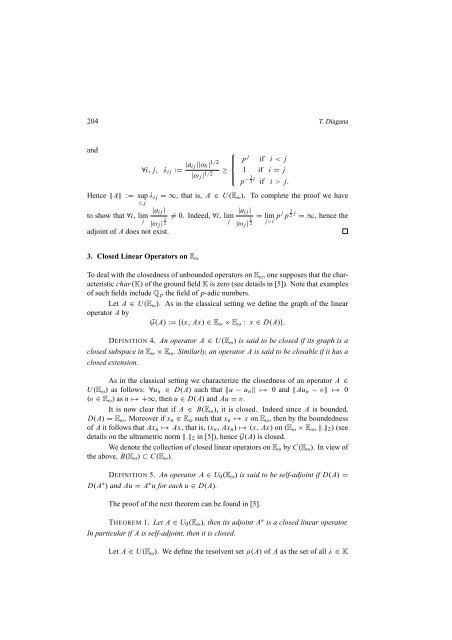T. Diagana INTEGER POWERS OF SOME UNBOUNDED LINEAR ...
T. Diagana INTEGER POWERS OF SOME UNBOUNDED LINEAR ...
T. Diagana INTEGER POWERS OF SOME UNBOUNDED LINEAR ...
Create successful ePaper yourself
Turn your PDF publications into a flip-book with our unique Google optimized e-Paper software.
204 T. <strong>Diagana</strong><br />
and<br />
⎧<br />
∀i, j, λ i j := |a i j||ω i | 1/2 ⎪⎨<br />
|ω j | 1/2 ≥<br />
⎪⎩<br />
p j if i < j<br />
1 if i = j<br />
p − 3 2 i if i > j.<br />
Hence ‖A‖ := sup λ i j = ∞, that is, A ∈ U(E ω ). To complete the proof we have<br />
i, j<br />
|a i j |<br />
|a i j |<br />
to show that ∀i, lim ̸= 0. Indeed, ∀i, lim = lim p j p<br />
j<br />
|ω j | 2<br />
1 j<br />
|ω j | 2<br />
1 2 3 j = ∞, hence the<br />
j>i<br />
adjoint of A does not exist.<br />
3. Closed Linear Operators on E ω<br />
To deal with the closedness of unbounded operators on E ω , one supposes that the characteristic<br />
char(K) of the ground field K is zero (see details in [5]). Note that examples<br />
of such fields include Q p the field of p-adic numbers.<br />
Let A ∈ U(E ω ). As in the classical setting we define the graph of the linear<br />
operator A by<br />
G(A) := {(x, Ax) ∈ E ω × E ω : x ∈ D(A)}.<br />
DEFINITION 4. An operator A ∈ U(E ω ) is said to be closed if its graph is a<br />
closed subspace in E ω × E ω . Similarly, an operator A is said to be closable if it has a<br />
closed extension.<br />
As in the classical setting we characterize the closedness of an operator A ∈<br />
U(E ω ) as follows: ∀u n ∈ D(A) such that ‖u − u n ‖ ↦→ 0 and ‖Au n − v‖ ↦→ 0<br />
(v ∈ E ω ) as n ↦→ +∞, then u ∈ D(A) and Au = v.<br />
It is now clear that if A ∈ B(E ω ), it is closed. Indeed since A is bounded,<br />
D(A) = E ω . Moreover if x n ∈ E ω such that x n ↦→ x on E ω , then by the boundedness<br />
of A it follows that Ax n ↦→ Ax, that is, (x n , Ax n ) ↦→ (x, Ax) on (E ω × E ω ,‖.‖ 2 ) (see<br />
details on the ultrametric norm ‖.‖ 2 in [5]), henceG(A) is closed.<br />
We denote the collection of closed linear operators on E ω by C(E ω ). In view of<br />
the above, B(E ω ) ⊂ C(E ω ).<br />
DEFINITION 5. An operator A ∈ U 0 (E ω ) is said to be self-adjoint if D(A) =<br />
D(A ∗ ) and Au = A ∗ u for each u ∈ D(A).<br />
The proof of the next theorem can be found in [5].<br />
THEOREM 1. Let A ∈ U 0 (E ω ), then its adjoint A ∗ is a closed linear operator.<br />
In particular if A is self-adjoint, then it is closed.<br />
Let A ∈ U(E ω ). We define the resolvent set ρ(A) of A as the set of all λ ∈ K














